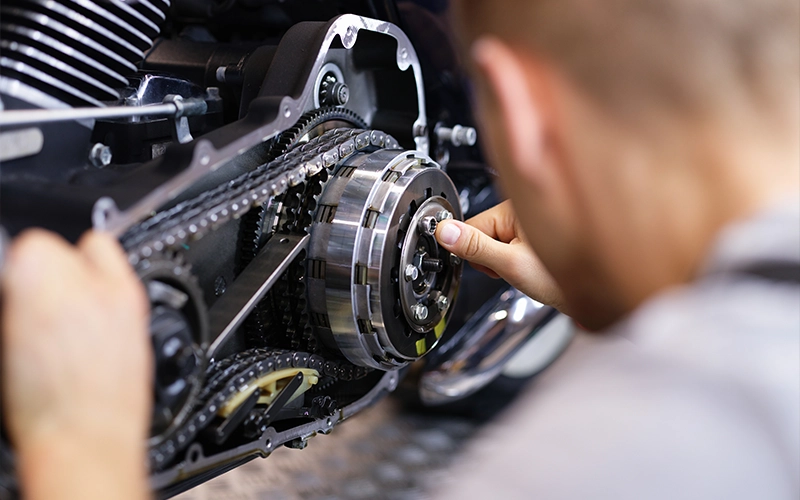Imagine this—you’re out on the open road, twisting the throttle, shifting gears effortlessly, and feeling that perfect harmony between man and machine. But what happens when that harmony starts to fade? You notice the gears slipping, acceleration feels off, and something just isn’t right. If you’ve ever experienced this, your motorcycle clutch plates might be crying out for attention.
At Aliwheels, we know that motorcycle performance is everything. The clutch system plays a critical role in ensuring that power from the engine is transferred to the wheels efficiently. But like every hardworking component, clutch plates wear down over time. If they aren’t properly maintained or replaced when necessary, you could end up with a bike that lacks power, stalls at the worst moments, or worse—leaves you stranded.
So let’s dive into everything you need to know about motorcycle clutch plate maintenance, how to recognize when it’s time for a replacement, and the best ways to keep your ride performing like new.
What Do Motorcycle Clutch Plates Do?
Your clutch plates are what stand between seamless gear shifts and a bike that jerks or lags when you ride. They’re part of the clutch assembly, which connects and disconnects the engine’s power to the gearbox. Without them, your motorcycle wouldn’t be able to stop without stalling or shift gears without grinding.
A properly functioning clutch ensures that you can control power delivery, making your ride smoother and preventing unnecessary wear on your transmission. But, like brake pads, clutch plates are designed to wear out over time due to friction and heat. If they aren’t well-maintained, they’ll degrade faster, leaving you with a slipping or failing clutch.
Signs Your Clutch Plates Need Attention
Most riders don’t think about their clutch until they start experiencing issues. But if you catch the signs early, you can save yourself from expensive repairs and a frustrating breakdown. Here are the telltale symptoms that your motorcycle clutch plates are worn or in need of maintenance:
- Clutch Slipping – If you twist the throttle, but the engine revs higher without an increase in speed, your clutch is likely slipping. This means your plates aren’t gripping properly, causing a loss of power to the wheels.
- Difficulty Shifting Gears – If shifting feels rough, sticky, or requires excessive force, your clutch plates might be worn or misaligned.
- Unusual Noises – A grinding, rattling, or chattering noise when engaging the clutch is a big red flag. This could mean worn-out plates or issues with the clutch basket.
- Spongy or Stiff Clutch Lever – If the clutch lever feels off—either too soft or too rigid—it could mean the clutch plates aren’t engaging properly due to excessive wear or lack of lubrication.
- Burning Smell – A strong, burnt smell when riding aggressively or in traffic could mean your clutch is overheating due to excessive slipping.
Ignoring these symptoms can lead to complete clutch failure, leaving you with a stranded bike and a hefty repair bill.
How to Extend the Life of Your Clutch Plates
Keeping your clutch plates in peak condition isn’t difficult, but it does require consistency. Here’s how you can ensure your clutch lasts as long as possible:
1. Use the Right Oil
One of the biggest mistakes riders make is using the wrong type of oil. Since your motorcycle clutch plates are bathed in oil, using an oil that isn’t designed for wet clutches can cause slippage and premature wear. Always check your manufacturer’s recommendations and go for high-quality motorcycle-specific oil.
2. Adjust the Clutch Cable Properly
Your clutch cable should have just the right amount of free play. If it’s too tight, the clutch plates will wear out faster due to constant partial engagement. Too loose, and you’ll struggle with shifting gears smoothly. Checking and adjusting your clutch cable periodically ensures your clutch operates at peak performance.
3. Avoid Riding the Clutch
One of the most common reasons for premature clutch wear is improper riding habits. If you constantly keep a finger on the clutch lever while riding, you’re putting unnecessary pressure on the plates. This keeps them partially engaged, causing them to wear out faster. Make sure you fully release the clutch after shifting to avoid excessive wear.
4. Perform Regular Inspections
Just like any other part of your bike, clutch plates should be inspected regularly. If you do a lot of high-performance riding or long-distance touring, check your clutch assembly for any signs of glazing or warping.
5. Replace Clutch Plates Before It’s Too Late
Once clutch plates start slipping excessively, they should be replaced. Riding with bad clutch plates can damage other components, leading to a bigger repair bill. Replacing them on time keeps your bike in top shape.
How to Replace Your Motorcycle Clutch Plates
If you’ve determined that your clutch plates are worn out and need to be replaced, you have two choices—take your bike to a professional mechanic or do it yourself if you’re comfortable with hands-on maintenance.
If you decide to replace your clutch plates yourself, follow these steps:
- Prepare Your Tools & Work Area
Make sure you have a wrench set, fresh oil, and new clutch plates that match your motorcycle’s make and model. - Drain the Oil
Before opening the clutch cover, drain the engine oil to prevent spills and mess. - Remove the Clutch Cover
Unscrew the bolts and carefully take off the clutch cover. You’ll now see the clutch basket and plates. - Remove Old Clutch Plates
Take out the worn clutch plates, making sure to keep them in order. This will help you install the new ones in the correct sequence. - Install New Clutch Plates
Before installation, soak the new motorcycle clutch plates in fresh oil for at least 30 minutes. This prevents dry friction on the first startup. Insert the plates in the correct order, alternating between friction plates and steel plates. - Reassemble & Refill Oil
Once the new clutch plates are installed, put everything back together, tighten the bolts, and refill the oil. - Test the Clutch
Before taking your bike for a ride, test the clutch by shifting through gears to ensure everything is working smoothly.
Replacing your clutch plates is a rewarding experience that not only saves money but also gives you a deeper understanding of your motorcycle’s mechanics.
Choosing the Best Clutch Plates for Your Bike
Not all clutch plates are created equal. If you want longevity, smooth performance, and durability, invest in high-quality clutch components. At Aliwheels, we offer premium motorcycle clutch plates designed for various bikes, whether you’re a street rider, off-road enthusiast, or sportbike lover.
Our clutch plates are made from top-grade materials, ensuring they withstand heat, friction, and high RPMs. Whether you need a heavy-duty clutch kit for performance riding or OEM replacements for everyday commuting, we’ve got you covered.
Check out our selection of motorcycle clutch plates here: Aliwheels Clutch Plates
Final Thoughts
Your clutch plates are one of the most important components of your motorcycle’s performance. Keeping them in good condition means you’ll have a smoother, more reliable ride with better power delivery. Whether you’re replacing worn-out clutch plates or maintaining them for longevity, giving your clutch the care it deserves will ensure your bike stays in peak condition for miles to come.
At Aliwheels, we’re passionate about motorcycles and helping riders keep their bikes performing at their best. If you need high-quality motorcycle clutch plates, maintenance tips, or expert advice, we’re here to help.
Ride smooth, shift effortlessly, and keep your clutch in top shape!










